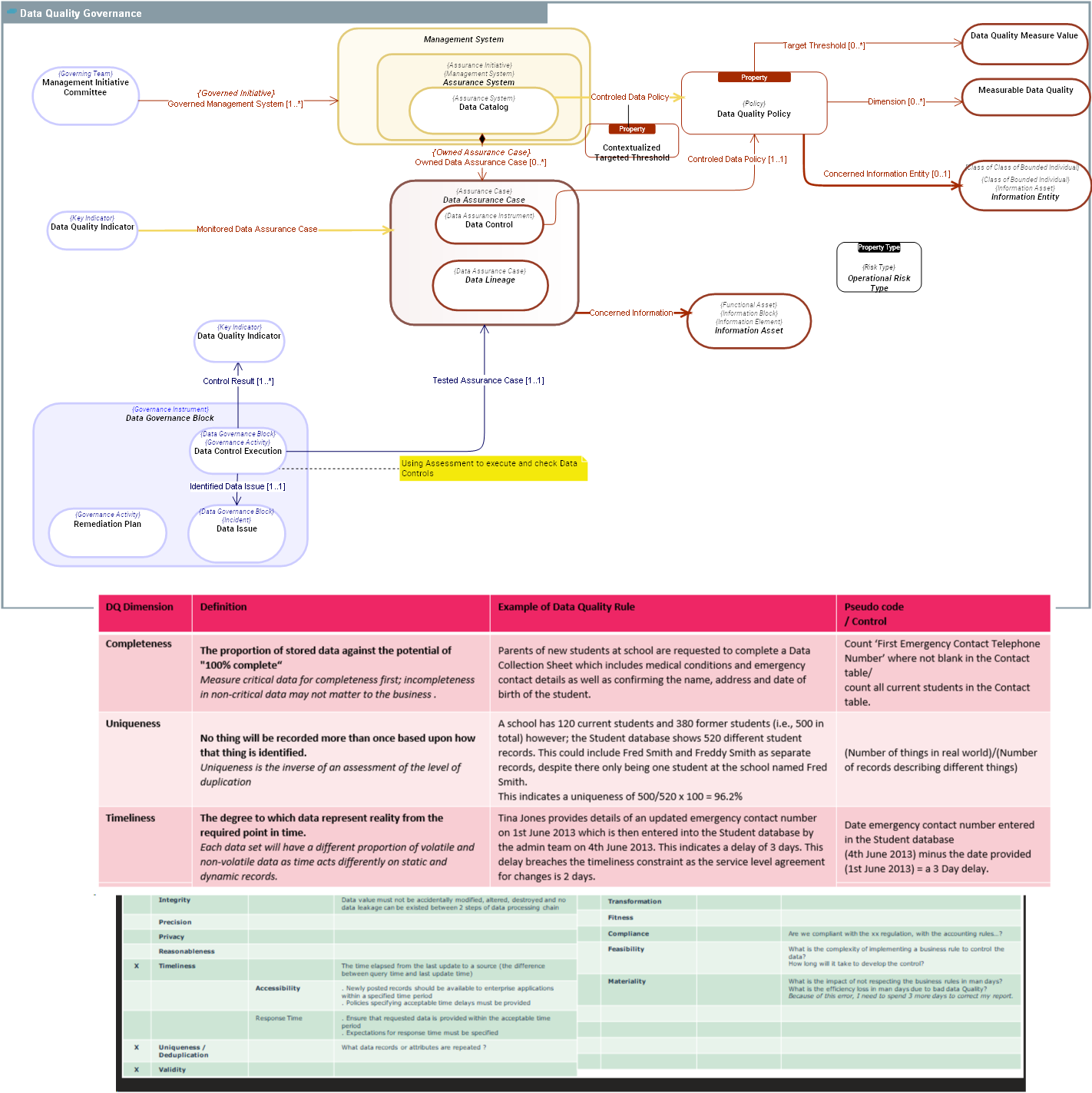CONCEPT DOMAIN - Data Quality Governance
| Description | |
|---|---|
| Dictionary |  Dictionary of SysFEAT concepts
Dictionary of SysFEAT concepts |
| Parent Domain | |
| Domain dependencies |  Teams Pattern
Teams Pattern |
DOMAIN CONCEPT GRAPH
Diagram Graph

CONCEPT DESCRIPTIONS
Concrete Concepts
| Concept | Description |
|---|---|
 Contextualized Targeted Threshold
Contextualized Targeted Threshold |
|
 Data Catalog
Data Catalog |
A Data Catalog is an Assurance System of Data Assets, ensuring understanding, trust, compliance and confidence of enterprise data. This includes: 1. Relationship with Enterprise Glossary to provide business context to metadata. 2. Data policy definition and enforcement to ensure data quality. 3. Data Lineage to master data provenance: where data comes from, how data is transformed, and where it is used. |
 Data Control
Data Control |
A Data Control is about tracking the quality of information as defined by Data Quality Policy(ies). |
 Data Control Execution
Data Control Execution |
Execution d'un data control effectué dans le cadre d'un data catalog. |
 Data Issue
Data Issue |
An issue is an event or difficulty encountered in the context of a business process, application or enterpise strategy. Issues are processed within the framework of projects as a function of objectives aiming at their resolution. |
 Data Quality Indicator
Data Quality Indicator |
|
 Data Quality Measure Value
Data Quality Measure Value |
|
 Data Quality Policy
Data Quality Policy |
|
 Management Initiative Committee
Management Initiative Committee |
A Management Initiative Committee is a Governing Team responsible for overseeing the administration of a Management System. |
 Measurable Data Quality
Measurable Data Quality |
|
 Remediation Plan
Remediation Plan |
Abstract Concepts
| Concept | Description |
|---|---|
 Assurance System
Assurance System |
An Assurance System is a Management System aimed at ensuring enterprise compliance, resilience, and risk mitigation against both internal and external Policys and threats. It encompasses processes, Directives and technologies that work in concert to validate enterprise adherence to policy requirements, industry standards, and internal policies while simultaneously bolstering the enterprise's ability to withstand and adapt to various challenges and disruptions. ensuring enterprise compliance and resilience against internal and external constraints: a. Regulation constraints: they defined what is allowed and not allowed by the law (See Regulation Article). b. Internal policies and rules constraints: they defined what is allowed and not allowed by the enterprise (see Business Policy). c. Operational constraints: they maintain operational capacities of the company (maintain ability to produce, maintain quality, ensure product development , ability to hire, to train, etc, see Business Rule). d. Architectural constraints: they guide design decisions and shape the overall structure of a system (see Architecture principle). |
 Data Assurance Case
Data Assurance Case |
A Data Assurance Case is a structured argument, supported by evidence, intended to justify that a data is acceptably assured relative to a concern (such as quality, safety, security or privacy) in the intended operating environment. The operating environment includes: 1. Policies related to the use of data in the organization (privacy policy, regulation policy, ...). 2. Data quality policies defined by the organization. 3. Risk to be mitigated in the use, consumption and sharing of data by the organization. 4. Control directives to be followed in the use, consumption and sharing of data by the organization.
|
 Data Governance Block
Data Governance Block |
Governance Resource uses in the context of Data Governance. |
 Data Lineage
Data Lineage |
A Data Lineage is about tracking the flow of information from source Information Assets to final Information Assets. It is necessary to guarantee the quality, usability and security of business data. For large organizations, it is also a key conformity legal requirement: BCBS 239, Solvency II. Business Data Lineage is defined as a business data life cycle that describes the source of business data and where it moves over time. |
 Information Asset
Information Asset |
An Information Asset represents anything that can be communicated or memorized by an Agent to produce and react to Outcome Events. An Information Asset is either an Information Entity or an Information Property. The difference lies in their relationship to change and to time. Information Entity(ies) can change over time and have a lifeycle while Information Propertys are immutable characteristics. |
 Information Entity
Information Entity |
An Information Entity is an Information Asset that is not fundamentally defined by its attributes, but rather by its continuity. An Information Entity evolves over time and has states. For instance a person is an Information Entity. Employe is a state of a person. An Information Entity has relationships to other Information Entitys and can have Information Propertys.
|
 Management System
Management System |
A Management System is a mezzo Enduring Initiative within an Enterprise, aimed at creating, maintaining, evaluating, evolving, and operating a collection of essential Functional Architecture Assets of the Enterprise. A Management System may transcend organisational boundaries and consequently requires an integrated team working under the direction of a Management Initiative Committee. |
 Operational Risk Type
Operational Risk Type |
An Operational Risk Type is a kind of Risk Type that refers to the potential for loss due to the enterprise's inadequate functioning. An Operational Risk Type is either Compliance Risk Type a or an Operating Risk Type. |
 NIST - Assurance Case
NIST - Assurance Case